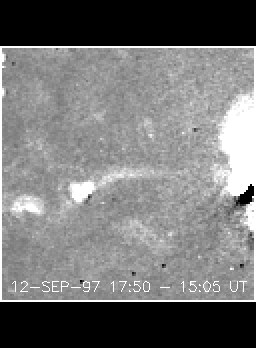
|

|
Actually the above left is an EUV image from SOHO, but we see it well enough also with Yohkoh (right), a difference image on an expanded scale. The interconnecting loop is just above disk center and runs from a medium-sized active region in the W to what we call a "bright point" (a miniature active region) just to the E of the central meridian; see the authors' figure describing the magnetic environment.
The phenomenon
The authors of the paper note that the interconnecting loop structure fluctuates in brightness, and that these fluctuations correlate with variations at the two ends. The figures below shows the variations: left, the bright-point emission; right, the loop brightness.

|

|
At early times in these two plots (their left sides) the variations correlate; at the right they do not. Note that the loop brightness fluctuations around the zero level at later times. It is too technical to describe properly here, but the authors show from a correlation analysis that energy is probably flowing from the larger active region towards the bright point. Armed with this fact, they discuss different scenarios for how energy actually might be transported bodily through a tenuous coronal structure. Normally we think of energy in the solar atmosphere flowing radially outwards, impelled ultimately by the sources of solar luminosity. But the corona is a tricky place, where magnetism causes strange and wonderful effects.
A recent related finding?
Check out this nice movie please:

Not bad, eh? This seems to show a jet unwinding from one bright point towards another, and leaving it excited. Is this substantial energy transfer or just "triggering"?
Conclusions
This is somewhat new territory. We have often (see [1] [2] [3] [4] [5] [6] [7] [8] ) discussed north-south (transequatorial) loop systems, and the in spite of all this attention we never even came close to the McDonald et al. ideas. It just goes to show that one must keep one's eyes open if one is to be a successful observer!
January 26, 2001